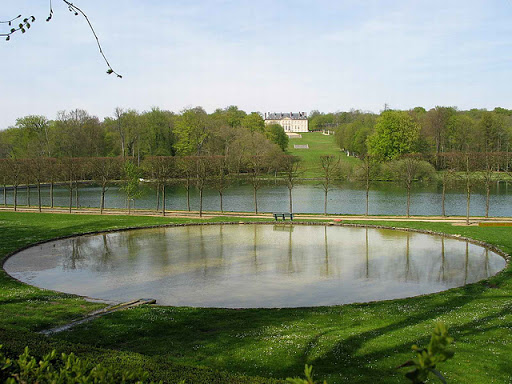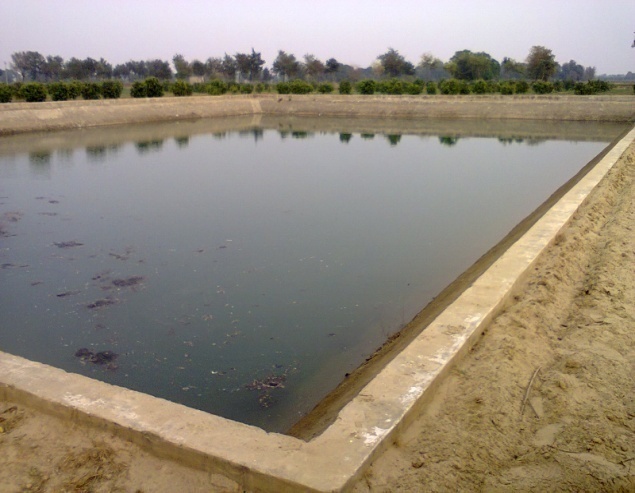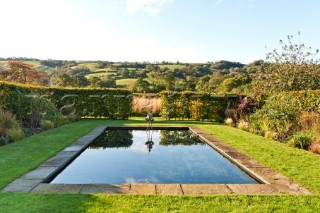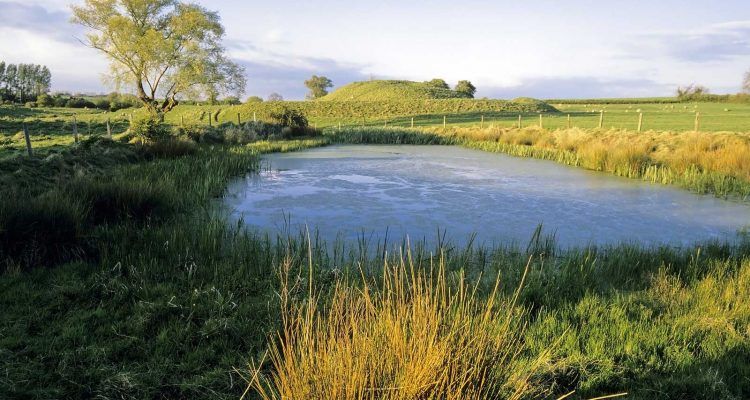जल संतुलन जलाशय: नहर कमान में एक कुशल जल भंडारण संरचना
Water balancing reservoir is also known as Diggies or Tanks or Farm pond or intermediate storage structures in canal command. It is a water storage structure in canal command to store the water delivered from the water courses to farms and regulate the flow of water for agricultural irrigation.
Water is pumped out of this and is distributed to the field through channels or micro irrigation system. It helps to supply irrigation water when the crop requires it, the most. All these interventions contribute to higher yield, production and water productivity.
However, water balancing reservoirs are shown to be cost-effective for landholdings above 4 ha. Thus, it can directly help medium to large fully irrigated landholdings. In India, 8 % of the irrigated landholdings are in this category and they account for 24 % of the irrigated land.
The right combination of water balancing reservoir or tank with canal command areas as inlet and micro-irrigation as outlet hold the key to achieve high yield and better quality of produce.
Need of water balancing reservoir in the canal command areas
Water balancing reservoir is very important water harvesting structure in canal command to meet the demand and supply of water to agricultural farm. It is advantageous in following ways:
- The water balancing reservoir may be helpful in balancing either canal water or ground water alone or conjunctively to meet the optimum water requirement of crops in the time of water scarcity.
- It may be helpful in planning for augment canal supplies, to combat water logging and facilitate irrigation with poor quality ground water.
- It will be helpful in deciding the appropriate method of application of water, irrigation levels that may improve the productivity of land, water and crops.
Shapes of water balancing structure
Water balancing reservoir can be constructed in various shapes and sizes i.e. circular, trapezoidal, rectangular or irregular shapes (Fig 1).
Cicular pond Trapezoidal Pond Rectangular pond Irregular pond
Fig 1: Water balancing structures
Design parameters of water balancing reservoir
Bottom width, top width & length, depth of ponding, cross sectional areas, storage capacity and volume of excavation is the major design parameters of water balancing reservoir. The storage capacity of the water balancing reservoir is important for the efficient operation of a water supply system.
Side slope of is very parameters for the design water balancing reservoir. It depends on the soil types and texture. Many parameters have been taken for the design of farm pond. Some of them are discussed below:
Hydraulic parameters of water balancing reservoir
The size of a farm pond is measured by its water surface area when the pond is full of water. Farm ponds typically range from 30 m2 to 500 m2, size depends on the resources of the farmer and larger natural ‘small water bodies’, like small lakes. Trapezoidal shapes of water balancing reservoir is most efficient than rectangular, square, circular, trapezoidal or irregular shapes water balancing reservoir.
The water balancing reservoir should be large enough to store sufficient water to meet both average and peak daily demands. Surface and storage volume of trapezoidal shape water balancing reservoir is calculated by using mathematical equations.
| Bottom width (B) | |
| Cross sectional area (A) |  |
| Storage capacity or volume (V) |  |
Where, B = Bottom width; T = Top width; Side slope = 2-2.5:1 (Horizontal/Vertical); d = balancing reservoir depth; A = Cross sectional area; L = length of the balancing reservoir; and V = Storage volume.
Volume of Excavation
The following formula can be used for determining the volume of excavation required for construction of water balancing reservoir. This formula is nomenclature as Prismodial formula.

Where, V = Volume of excavation (m3); A = Area of excavation at the ground surface (m2); B = Area of excavation at mid-depth point (m2); C = Area of excavation at the bottom of the balancing reservoir (m2); D = Average depth of pond (m).
Dimension of water balancing reservoir
Depth of balancing reservoir
Depth of the pond should range from 3 to 5 m. Greater than 2 m of depth is necessary and would require less area as well as minimum evaporation loss and maintenance hazard. When the construction is done with human labour, any increase in depth beyond 3.5 to 4.0 m becomes uneconomical. Hence, a depth of 3 to 4 m may be suitable in general for the ponds.
Slope of balancing reservoir
1.5:1 to 3:1 slopes has been recommended for clay to sandy loam soil. The side slopes are decided by the angle of repose of the sub-soil. The constant action of standing water may require relatively flatter side slopes to avoid slippage due to saturation. Generally, side slopes of 2:1 or flatter are adopted.
Bottom side
When the volume of the balancing reservoir is known and the depth and side slopes are fixed, the side of the bottom square can be obtained from the following formula

Where, B = Side of bottom square (m); V = Volume of balancing reservoir (m3); D = Depth of balancing reservoir (m) and n = Side slope ration (horizontal: vertical).
Top side
The bottom dimensions are known, the side of the top square can be obtained from the mathematical formula

Where, T = length of side of balancing reservoir at the top (m).
Water balancing components in reservoir
Size of the water balancing reservoir mainly depends on the irrigation management strategies of the crops to be grown in the canal command area and the natural inflow and outflow components of the structure (Fig 2). The inflow components consists of canal supply, tube well supply and the rainfall on surface area of the water balancing reservoir, whereas the outflow components are the seepage & percolation and evaporation losses. Hence, a mass balance of the inflow and outflow components of the crop fields as well as the water balancing reservoir including the irrigation demand of crops seems to be a correct approach, for making a decision on the size of the water balancing reservoir for a particular period of rainfall events. The daily water balance in balancing reservoir is described by Water-Budget equation:
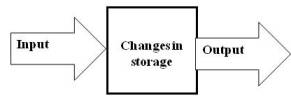
Fig. 2: Water Budget model
Generally, water budget model is expressed in equation as

Mathematically, water budget model can be expressed as

Where,
P = Precipitation; RO = Surface runoff; AET = Actual evapotranspiration; I = Interflow; D = Groundwater discharge; A = Anthropogenic inputs and/or supplies/abstractions; ΔI = Change in land surface storage; ΔS = Change in soil moisture storage; and Δg = Change in groundwater storage.
Inflow components
Rainfall occurrence on the surface area of water balancing reservoir
Rainfall on the balancing reservoir water spread area is determined as

Where, RT = rainfall on balancing reservoir (m3/day), R = daily rainfall (m/day), TA = water spread area balancing reservoir (m2).
Canal water supply
The irrigation system consists of a large network of main canals, branch canals, distributaries, minors and watercourses. Canal water availability is estimated by multiplying size of land holding with duty of water.
Groundwater supply
Groundwater availability and quality data obtained from Central Ground Water Board, India. Groundwater potential collected data i.e. net annual groundwater availability, existing gross ground water draft for irrigation, net groundwater availability for future irrigation development, groundwater level in different observation wells monthly ground water table data depth in last one decade and groundwater quality (i.e. pH, EC, etc.) and other cationic and anionic parameters helped in deciding the quality of groundwater for irrigation and also for design of balancing reservoir.
Outflow components
Evaporation
Evaporation from surface of balancing reservoir is computed as

Where, E = evaporation (m3/day), Ep = pan evaporation (m/day) and TA = top area (m2).
Seepage and percolation
The seepage and percolation water through the balancing reservoir bed and the embankment (referred to as the balancing reservoir seepage) represents a significant component of the balancing reservoir water reduction. The constructed tanks were RCC. So, there are no seepage or percolation losses from balancing reservoir.
Crop water requirement
In canal command areas, water supply is irregular and not a regular interval. Under this situation, to meet the crop water requirement at regular interval is not possible directly through canal operation. The reference crop evapotranspiration (ET0) is calculated by using CROPWAT software. The ET0 value is used in the calculation of water requirement of major crops of research area is described in following equation:
Water requirement (WR) of crop

Peak volume of water needed to the crop (Vpeak)

Where Kc = Crop coefficient, A = Area coverage by different crops (m2) and Vpeak = peak volume of water needed to the crop (m3).
Water requirement of major crops grown in the canal command are follows as shown in table (1).
Table 1: Water requirement for different crops
| Major crops | Total water requirement (mm) |
| Rice | 1100-1250 |
| Wheat | 500-600 |
| Groundnut | 500-550 |
| Finger millet (Ragi) | 350 |
| Sugarcane | 1800-2200 |
| Maize | 500 – 600 |
| Cotton | 550 – 600 |
| Sorghum | 350-500 |
| Redgram, Blackgram, Greengram | 200-450 |
| Mustard | 300-400 |
Conclusions
Water balancing reservoir is the most important water storage structure in canal command areas. In canal command areas, canal water supply is irregular and not frequent. Under this condition, crop water requirement at different stages are meet with water stored in balancing reservoir.
Balancing reservoir is an intermediate water storage structure which stored water from canal during canal supply and delivered water to field during lean period of canal supply. It is farmers’ friendly and cost-effective technology in canal command areas.
This technology reduces water losses and improves land and water productivity.
Author:
Pawan Jeet, Prem Kumar Sundaram, AK Singh, Anup Kumar, A. Upadhyaya and DK Raghav
ICAR-Research Complex for Eastern Region, Patna-800014
Email:

